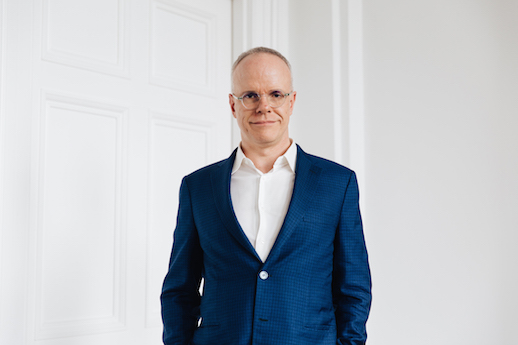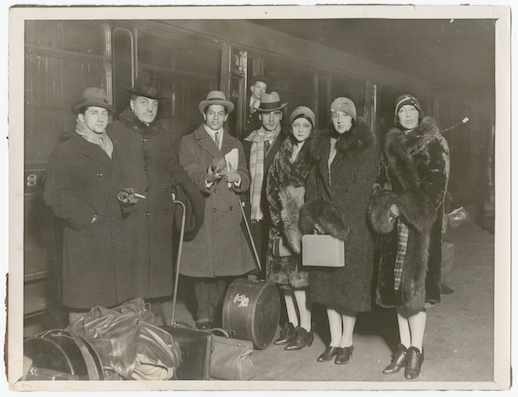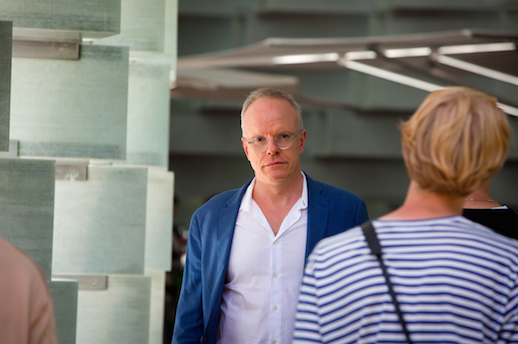An Interview with Hans Ulrich Obrist

It seems that you emphasize “plurality.” For example, having connections and dialogues with various art genres, encouraging multi-person curation, organizing exhibitions in multiple places. What does plurality mean to you?
Obrist: Releasing polyphony is always a big part of my work. It is also about generosity. It’s an important aspect of curating. I think that the idea was significantly influenced by my great mentor, Edouard Glissant. He is a poet and thinker. We didn’t have enough time to talk about Edouard Glissant at the lecture yesterday, but his influence on me was so big. I still read his works for the first fifteen minutes every morning, even in Tokyo. We had always gone on journeys together. I wrote about these experiences. Now I am working on a movement to make Edouard Glissant available for everyone (*1).
In the early 20th century, Stefan Zweig (1881-1942), a critic, mentioned that homogenization would make the world poor and endanger cultural phenomena, ultimately maybe our civilization, and our own species. You can observe it right now anywhere. Edouard Glissant also predicted that there would be a counter-reaction already in the 1970s. He was alarmed by new localisms and nationalisms as counter-reactions of homogenized globalization. Instead, he suggested polyphonic globalization. For example, polyphonic museums. The idea of the museum came from the dialogue with Wilfredo Lam (1902-1982)and Roberto Matta(1911-2002), and was almost achieved in Martique, the Caribbean island where Glissant was born.
What kind of museum is a “polyphonic” museum?
Obrist: Glissant wanted to make institutions like an encyclopedia that would historicize and compare the art of the Americas. Glissant defined it as an “archipelago” because an institution should be an interrelated network of various traditions and perspectives. I think that is the key point.
I always pursue this polyphony of perspectives and make my exhibitions active laboratories that do not illustrate previously established findings. I want us to quest or to search for something we have not known yet. In the end, “The museum today is the place for bringing some of the world’s places into contact with each other. We must multiply the number of worlds inside museums.” With the idea of an archipelago, both individual identity and collective identity will not be stereotyped but flexible. Then, when we encounter others, we do not lose our identity or self, but are enriched instead.
The idea of archipelago is a negation of the idea of continent, which rejects mixing or creolization.
Obrist: Yes, it is. For example, now we are having a conversation and I can change through the exchange with you, and it makes myself richer. This kind of idea is the way to resist this nationalism, localism, and racism coming up all over the world. We need to create new dialogue and bridges, and we, as curators, need to create bridges and connect others.

What do you think are common points among different art genres? I have read your book, A Brief History of New Music, and you asked composers about visual art and literature. This seems that you perceive fine art, music, and literature as multiple genres that belong to the big idea of art.
Obrist: I appreciate you reading the book, thank you. In the book, I introduce “Gesamtkunstwerk,” a concept of Wagner’s. This is an important concept for me, but there is a sense that late Wagner is somehow dangerous because it overwhelms and diminishes the viewer. I want to empower the viewer, create oxygen and give them space to breeze through Gesamtkunstwerk as a group show. It is again about polyphony.
Have you ever heard of Sergei Diaghilev(1872-1929)? He was a Russian impresario who used to be a painter and curator, but later he realized that he wanted to somehow expand his art practice to ballet. In 1911, he invented Ballets Russes, the Russian ballet group. Moreover, he worked on some of his productions with Picasso and Stravinsky and Korsakov, a great composer of his time. Because of curators who relate to multiple genres like Diaghilev, I decided to become a curator.
You have interacted with many architects such as Rem Koolhaas, Kazuyo Sezima, and Zaha Hadid. This also indicates that you have conscious connections to multiple genres.
Obrist: Yes, that is true. Both Yuko Hasegawa and I are working in both art and architecture. I have had similar ideas after meeting many architects. I read Giorgio Vasari at a young age, met Kazuyo Sejima, and talked with Zaha Hadid. I realized that art and architecture have no boundaries. And next is music, fashion, science, and technology. I met many mentors in various fields and there will be no end to my list.
Do you have any stories of your experiences?
Obrist: Yes. I have many of them. Pierre Boulez, the composer, told me that he makes the “score of the score,” which is additional information only for the composer. This surprised me and made me consider, “What is the score of the score for artists?” I came up with many ideas at that time. I research in all kinds of fields, which creates interdependence. In order to challenge inequality in society, or the extinction crisis of the 21st century, the interdependence of the fields will be strongly needed. This is why salons are very important.
You conduct “marathons” as today’s salons. For instance, “Interview Marathon” for which you did not sleep at all for 24 hours and talked to people in London, and “Experiment Marathon,” in which you combined conversations, performances, and presentations.
Obrist: Yes. In addition to “Marathon,” I do many private salons, because a city regrettably does not function as a city. There are no spaces where different disciplines can meet.
It is a very important part of my curator job to place situations that “break open.” The curator creates junctions. This is why I make exhibitions among objects, quasi-objects (*2), hyperobjects (*3), and non-objects.
By the way, I want to have a global movement to reintroduce the use of night trains. Both in Europe and Japan, we discontinued the use of night trains. I engaged in visual art research and visited a lot of artists when I was 17 years old. I went on night trains and traveled all over the world. I had always been very much committed to night trains. Night trains are like a salon. Berlin Biennale was planned on a night train. It was the night train to Venice. I, as a student, met Klaus Biesenbach, and this led to the first Berlin Biennale. “Reintroduce night trains.” This is my message to Japanese railway. Using trains is also important because of ecological reasons. Today we have an ecological crisis. We should rely less on airplanes and more on night trains.
There seem to be more opportunities to see artworks on Instagram and the internet than in art museums and galleries today. In this situation, what do you think are the prospects for physical art spaces such as art museums and galleries?
Obrist: Do you mean that Instagram and social media are threatening actual museums?
I do not necessarily mean that. While you can view artworks on the internet, we still visit art museums and galleries to see art. I would like to ask you how you think about visiting physical art spaces.
Obrist: I see your point. But, at the Serpentine Galleries, the number of visitors is increasing. I feel that people want more experiences with artworks in a physical space. Exhibitions used to have a function of providing information. However, with the explosion of images and information on the internet, museums should be places of transforming information into knowledge.
We should not forget the anthropologist Margaret Mead (1901-1978), who in the 1950s wrote a text pointing out visual-centered experiences and the multi-sensory rituals of different cultures in previous centuries. I think that people desire this kind of ritual experience appealing to all the senses, and this is today’s trend. Museums are open for comparatively long hours. You can go back and forth there. This is a key difference from plays or operas at a theater, where you have to go on time.
People may involve themselves in rituals as a way of distancing from the onslaught of information.
Obrist: Yes. For example, our recent project is Marina Abramović. She asked visitors to leave their mobile phones or smartphones at the entrance of the exhibition.
Also it’s interesting that we have a lot of experiences with pioneering artists that are somehow off the grid. Luchita Hutardo, who was born in 1930 and had a first solo exhibition at the Serpentine; Faith Ringgold, who was born in 1930 and had a solo exhibition in 2019. Both these great artists had been neglected and were not widely represented on the internet. It’s only by actually bringing them to museums that they have become known. Hutardo was selected as one of the Time 100 most influential people of the year. I would say that a function of the museum is protesting against forgetting.
You mentioned exhibitions as a ritual appealing to multiple senses and art museums as “memory devices.” How about technology? The Serpentine Galleries introduce artists who use new technology as new media.
Obrist: Yes. I believe that it is interesting and important to embrace new technology. But at the same, I keep the critical stance of Herbert Marshall McLuhan and never forget the danger of it. With Ben Vickers, the chief technology officer of the Serpentine, I have introduced artists trying to practice art and technology, such as Hito Steyerl, Ian Cheng, and Sondra Perrydo.
When we had the Hito Steyerl exhibition earlier in the year, we were invited to use her two apps. One app is a map showing the inequality of Kensington. The other app she curated imagined the garden of Kensington in the future. You could actually see a video installation with bamboo there. It was open to diverse experiences in the future. Arthur Jafa invited artists showing their works only through Instagram and YouTube to present in exhibitions.
So, there are two movements in art museums. One is the protest against forgetting. The other is providing experiences you cannot have on screen. A function of the exhibition is to log off from the internet and make you slow down.
Finally, could you tell me about your recent interests? Like Christian Boltanski, you have said in your book Ways of Curating that “Exhibitions have to create the rules of new games.” What kind of rules of new games are you thinking of now?
Obrist: With our “Back to Earth” project at the Serpentine, we are working on a new “Do It”(*4)related to the environmental crisis. I am interested in how I can make some of these algorithms visible. New rules for algorithms will be made, or algorithms will be written by artists.
The idea of the rule of the game originally derived from the Oulipo, a poetry group. My rules of the game always come from conversation with artists. Christian Boltanski, who I met when I was sixteen, clearly gave me many rules of the game at shows, and we developed them together. Another artist who emphasized rules of the game was John Anthony Baldessari, who sadly passed away on January 2nd. As Alex Israel wrote on Instagram this morning, “Los Angeles will never be the same without him—and neither will the world.” His fearless investigations and experimentations in his art should not be forgotten. I have been asking many artists, “Are there any unrealized projects?” Baldessari said “I want to be a novelist,” and I helped with his writing. His text is very beautiful, undaunted, and endlessly suggestive, full of humanity and wisdom. Also, he said that a lot of ideas of rules of the game of course raise various questions about today. I think that artists always bring about rules of the game and they tend to react to the extinction crisis.
“Extinction” is a keyword. You have used it many times today.
Obrist:
Yes. Extinction of human beings will be the theme for our 50th anniversary of the Serpentine. We don’t really look back but look forward to the next 50 years. As you can see from Ian Chen (*5), the idea of artworks, in the age of AI, becomes living organisms shifting forever. I think about ideas of how the exhibition can relate to living organisms. I have made almost 350 exhibitions in my life and I see the new rules of the game are going beyond exhibitions and the temporality of exhibitions. In a way, exhibitions are still often a part of event culture, even sustainable models of exhibitions such as “Do It” are. They have an opening and a closure as general exhibitions do. Pierre-Hugues said that he wants to have his experiment conducted in Documenta and Munster on an island, where such an experiment will go on for fifty or a hundred years. The idea is to create a project of such a long duration that we somehow renew the “rules of the game,” which will be the key phrase.
(*1)At the 2013 Paris Nuit Blanche, Obrist printed and distributed a booklet by Edouard Glissant.
(*2)According to The Parasite (1987) written by Michel Serres
(*3)The concept which explains object ranges in time and space, such as “beyond localization.” For example, climate changes and styrofoam. Suggested by philosopher Timothy Bloxam Morton. Obrist and Morton spoke about this in an interview on the website dis.
(*4) Instructions that people all over the world follow to make artworks. The first “Do It” was conducted in Austria in 1994 and after that exhibited around the world.
(*5) In 2018, Ian Cheng showed the animation work “BOB” at Serpentine Gallery. “BOB” means “Bag of Beliefs.” Having the autonomous characteristics of AI and myxomycete, it shows different reactions toward visitor’s actions.
Hans Ulrich Obrist
Curator and writer. The director of the Serpentine Galleries in London since 2006. Previously curator for the Museum of Modern Art of the City of Paris. He works not only with artists but also architects, scientists, designers, directors, choreographers, and thinkers. His interdisciplinary approach is well known. He is famous for “Do It”(1993-), “Take me (I’m Yours)”(1995), “Cities on the Move” (1997-1999), “Laboratorium”(1999), and 300 other exhibitions. His publications include conversations with Rem Koolhaas and Zaha Hadid, Ai WeiWei Speaks, Project Japan: Metabolism Talks, A Brief History of Curating, and Ways of Curating. He is one of the most powerful contemporary curators in today’s world.
Shinya Sugawara
Art Critic. Born in 1974. Works include letters between Koki Tanaka in Question(ART iT)(Apr to Oct 2016), an interview with Yuki Okumura in Bijutsutecho in Aug 2016, and art reviews on the website of Bijutsutecho. Wrote Okamoto Taro’s Finding Japan – Traditionalism and Ethnic(Pan no Pan 04)and others.

*Translated from the Japanese.



